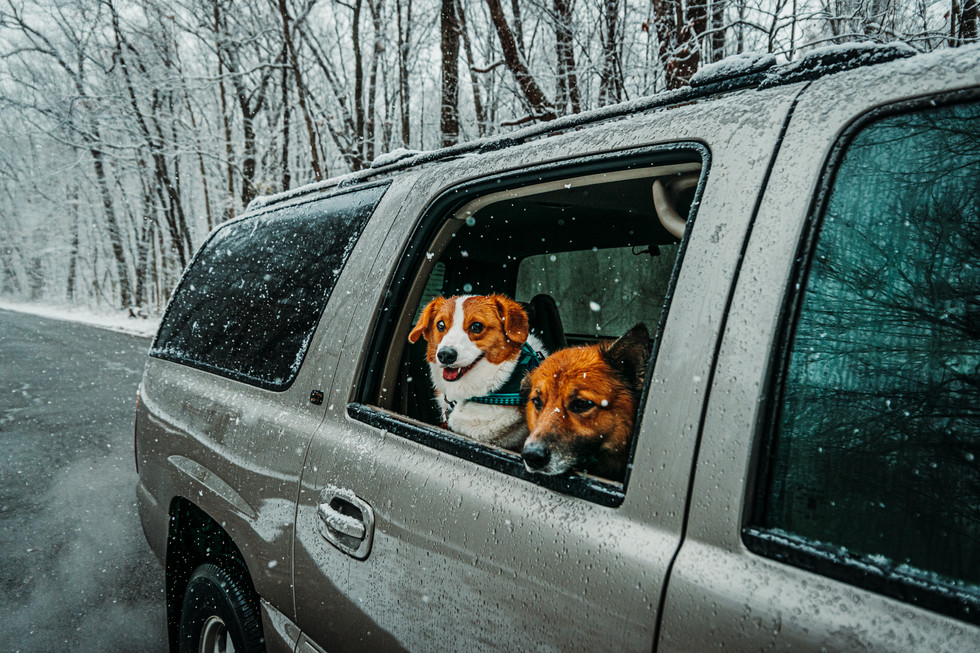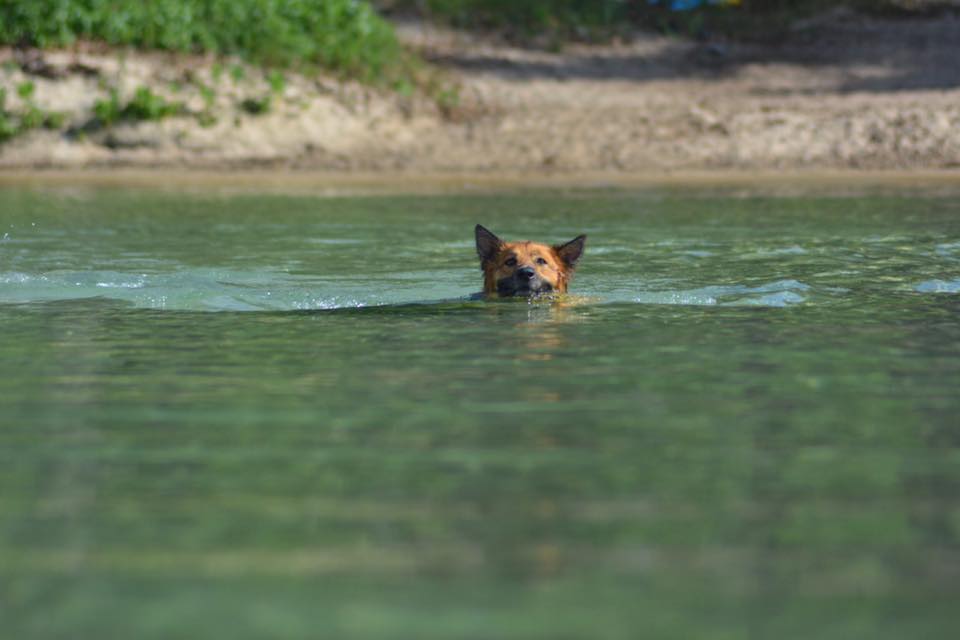Mitten Made Pups: Planning a Trip with Your Dogs
- Sam Hageman

- Feb 14, 2021
- 9 min read
Traveling with our dogs is essential, we rarely plan a trip without them. Both of our dogs have traveled far & wide. Dexter has been to 48/50 States in the USA, all over our home state Michigan, & Canada. Alfred flew from China to Chicago, drove with us home to Michigan, & has explored all over Michigan within the year we have had him. Although both dogs are well traveled, there are some essentials we have learned over the years to make sure we are prepared when planning a trip with the dogs.
PLANNING WHERE TO GO:
When planning a trip with dogs it is always important to figure out where you can go with your dogs. We have learned a lot about where to find pet friendly locations. The best places to find rules & regulations for a location is at the source.
(a) US National Parks are usually the LEAST pet friendly of all the available options. There are some exceptions we have traveled to, including but not limited to Acadia National Park, Grand Canyon National Park, Cuyahoga Valley National Park, Great Sand Dunes National Park, & more. However, even these parks have their limits. The best advice I have is to go to the National Park website for the park you want to travel to & go to "Plan Your Visit," Basic Information, & then "pets" is usually listed as an option. Start your search for National Parks here.
(b) US National Forests are one of the best alternatives & are usually very close to National Parks. National Forests are very pet friendly & many even allow dogs to be under voice control or leash in some areas. There still can be some limitations in National Forests, but you can find out where dogs are not allowed & the rules for each park on the National Forest website. You just need to search by State or Park name, then you may have to do some digging or google "______ National Forest Dogs" (this is due to every National Forest having their information organized differently, sometimes it is in "Recreation," "Rules," or "Outdoor Safety & Ethics"). You can search more information about the National Forests here.
(c) State Parks are probably my personal favorite in the USA. No matter where you travel, most states in the USA have a ton of State Parks. Every state differs on their rules & regulations for dogs. Thankfully Michigan State Parks are VERY dog friendly & allow dogs almost everywhere. Check out my blog here to see our Michigan State Park Checklist.
Further click the state you want to visit & the state park you wish to visit, then find whether they are pet friendly or not:
(d) Canadian Nationals Parks are more dog friendly than US National Parks. There are still many rules & regulations in every Canadian National Park regarding dogs though. Similar to the US National Parks, you will select the park you wish to visit, click "Plan Your Visit", then you will go to "regulations," & scroll down until you see "Pets." To find out more about Canadian National Parks, click here.
(e) Canadian Provincial Parks are similar to State Parks in the USA, but for every Canadian Province. There are some amazing places you can travel in every Canadian territory, however be aware it may be difficult to travel to the more northern Provinces as some require planes to get there which may not allow dogs. To discover the Provincial Parks in each Province & search their restrictions for dogs, click the Province below:
(f) AllTrails is a great website & app to use to find trails in areas you are looking to hike & travel to. You can type in an area, search based off your current location, or use the map to explore different trails listed. You can usually see in the caption if the trail is dog friendly. These trails do not always include every trail in the area or that a park has to offer, however it can help you find more city or county trails that are usually more difficult to find. You can find more information here.
(g) Social Media can also be a good resource for where you want to travel. If you follow people in other locations or read other blogs, sometimes you can find spots you want to travel with your pets. You can save photos, blogs, etc on your social media sites to refer back to them or even contact the poster if they are willing to share their knowledge of the area. I will warn you not everyone is a fan of sharing locations & there are many who believe social media has harmed the outdoors. However I do not believe in gatekeeping the outdoors from anyone & believe there are many out there like myself who love sharing their knowledge with fellow travelers & dog owners.
PLANNING WHERE TO STAY:
(a) Camping: The resources listed above usually include camping as well. Many of these parks include backcountry camping, modern campsites, cabins to rent, & some even have local places you can stay or rules on dispersed camping. However many of them have rules & regulations that may exclude dogs, so you will have to double check the parks website prior to booking your stay.
(b) Hotels/Rentals: There are many hotel websites that allow you to filter out pet friendly places to stay. When you decide where you want to visit, you can find the city or town nearby, look them up on the hotel website of your choice, filter pet friendly, & search from there based off of what you are looking for. When searching for hotels make sure you check what the pet fee may be. There are some hotel chains that have no pet fee, including Red Roofs & Super 8's. LaQuinta was our go-to pet friendly hotel chain with no fee, however since being purchased by Wyndham Hotel in 2017 many locations have started charging a pet fee. Most pet fees range from $10-25 a night, but check the hotel & their policy prior to booking as some add charges based on the size or will not allow pets over a certain size.
(c) Friends/Family: This is clearly always an option, but not as much during COVID-19. Clearly if you are looking to save some money or spend time with friends or family that would love your dogs to visit too, then it is your best option & a win-win.
PLANNING WHAT TO BRING:
We all know we have to pack prior to any trip, but when traveling with dogs you are also packing with them. I am an avid believer in writing a packing list a few days before your trip, especially for larger trips. There are a few tips I have for preparing your own packing list for yours dogs:
(a) Know Your Dogs Needs: One of the most important things will be knowing what your dogs need. Some dogs have double coats, some dogs have digestive issues, some dogs can only stand certain temperatures, some dogs love water, some dogs hate rain, & much more. You will have to evaluate what your dog will likely be doing & what they will likely need on the trip you plan. For example, Dexter has bad allergies & we know that we need to bring his allergy drops in a cold cooler with an ice pack no matter where we travel.
(b) Check the Weather: I thoroughly believe in constantly checking the weather for where you plan to go. This can be very important for your dogs, especially in drastic weather seasons like summer or winter. We have two double coated dogs, so we are always concerned with over heating in the summer or if it hits below freezing we are concerned with snow balls gathering on the dogs coats/paws. So for example if we are planning a trip to the U.P. of Michigan in the winter where the temperatures will be below zero degrees Fahrenheit then we know both Alfred & Dexter will need their Ruffwear climate changer coats to keep them warm; Dexter will need his socks & Ruffwear PolarTrex to prevent snow balls from gathering in his paws/causing irritation on his paws; & Alfred will need his Mushers or Paw Balm to prevent irritation on his paws from the cold.
(c) Conditions Where You Are Traveling: This is a bit different then the weather, as this includes knowing trail conditions, if there will be access to water your dog will swim in, how far you may be hiking, the type of bugs in the area (ticks, mosquitos, etc) & more. An example would be knowing you are going to hike a wetland in spring, the likelihood of mud will be high. This is a situation where we would need to bring towels to make sure we can clean the dogs off before entering the car & clean them off to check for ticks.
(d) Food: Clearly our dogs need to eat just like they would at home, including any supplements or medicine you put in their food daily. You should pack for the number of days you will be gone, but you should also always be prepared for at least an extra day as a precaution & potentially pack extra if you plan intense activities with your dogs (as your dog will be burning more calories then normal). Also if your dog has a hard time eating outside the home, consider packing something that will make them eat (like treats you can add to their food). For us, Dexter will only eat at night while we are on vacation & hates eating in the morning. We usually will pack his normal food along with some extra food toppings to help him enjoy eating somewhere away from home.
(e) Water: We all know our dogs need water, but it is very important to make sure your dog gets water in the car. Dogs can become very dehydrated in the car. We always have at least two full bottles of water in the car for the dogs on any car trip that will take at least an hour. If the trip is three hours or more we add a bottle of water for every hour added or we make sure we have our water cooler that holds three gallons of water (or an alternative is having gallon jugs of water). This will help male sure everyone stays hydrated on the trip there & you can bring them along for any hikes or adventures you take on the trip.
(f) Leashes: Make sure to always have a leash for your dogs wherever you travel, even if you have a dog who is under voice control in an area where it is allowed. A leash can be a good source to save your dog from other animals or even to leash when you pass another dog on leash or other humans who may be scared of dogs. This is a way to allow everyone to enjoy the outdoors & keep everyone safe.
(g) Identification: This can be as simple as a tag on their collar or harness, or it can include making sure your dog is microchipped. There are many options for identification, but the most critical thing is to make sure if anything happens where your dog gets lost that there is a way to get ahold of you. Just always make sure the information on the identification or microchip is updated.
(h) First Aid: We always make sure to have a first aid kit that serves its purpose for us, as well as for the dogs. The kit is a general first aid kit that also includes vet wrap, tick remover, & Vetericyn Plus (to clean wounds/cuts for pets). You also may need to add or subtract things to your first aid kit depending on our trip. For longer backpacking trip or hiking in tough terrain you may want to include an emergency carrier in case your pet gets injured & you need to carry them. It all depends on where you are going & what your dogs may need.
(i) Poop Bags: YOU SHOULD ALWAYS HAVE THESE! Do not be the jerk who does not pick up after your dogs. Dog owners get a bad reputation in the outdoor community due to people failing to do something as simple as pick up after their dog. Clearly there are certain circumstances where this may be difficult, like when your dog gets sick in the middle of a trail & you cant pick up anything because its liquid. Then no matter how hard you try you just cant get their poop up...yes we have been there & it is an awful feeling, but accidents happen/sometimes you cannot control these moments. However these are RARE situations & you should still try to do what you can to allow everyone to enjoy the outdoors. So do not be that jerk.
There are so many things that you could potentially pack based on your circumstances & the trip you are planning with your dogs. So here is an example of a list that we will be using for our winter trip to the U.P.:
Natural Balance Dog Food: 8 meals for both dogs (28 cups of food)
Doggie Dailies Supplements (Probiotic & Hip/Joint)
L-Theanine Supplement
Dexter Allergy Drops (in lunch cooler with ice pack)
Ruffwear Kibble Kaddie
Stella & Chewy Weenies (2 bags)
Kairos Treats
Dog Bowls (3 metal, 1 collapsible)
Woodland Wears Co Adventure Pack
Travel Water Bottle (2) & Water Cooler
Ruffwear Climate Changer (one for each)
Ruffwear Polartrex & Socks for Dexter
Mushers/Paw Palm for Alfred
Hair Brush
First Aid Kit/Vet Wrap/Vetericyn Plus
Doggie Dailies Ear Cleaner
Wild Wear Pets Collars (2 for each)
Copper Paws Tags (one on each collar)
Wild Wear Pets Bandanas
Ruffwear Harnesses (2)
Ruffwear Leashes (2)
Harbor Hound Traffic Leads (2)
Stuffed Dog Toys (2)
Small Blankets (2)
Hope these tips can help you plan your next trip with your four-legged adventure buddy!



























































Comments